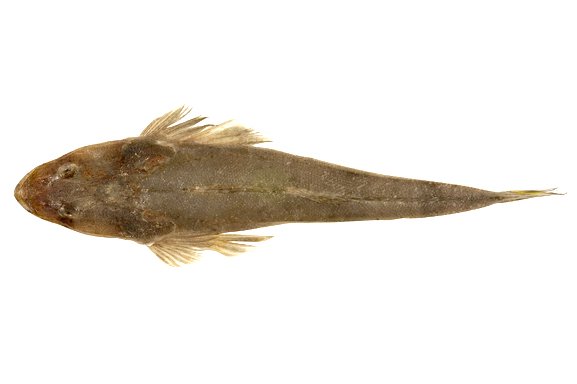Bartail Flathead, Platycephalus australis Imamura 2015

Bartail Flathead, Platycephalus australis. Source: Australian National Fish Collection, CSIRO. License: CC by Attribution-NonCommercial
In Australia, this species was known as Platycephalus indicus on most references prior to 2015. P. indicus occurs in the Indian Ocean and Indonesia.
Bartail Flathead, Platycephalus australis Imamura 2015
More Info
|
Distribution |
Endemic to northern Australia from Exmouth Gulf, Western Australia, to Moreton Bay, Queensland. Inhabits soft bottoms in estuaries (sometimes up to freshwater), bays and coastal waters to depths of 40 m. |
|
Features |
Dorsal fin I + VII-VIII + 0-1, 13-14 (usually I + VIII + 0, 13); Anal fin 13; Caudal fin 16; Pectoral fin 18-21; Caudal fin 9-13 (usually 12); Pelvic fin I, 5; Gill rakers 1-2 + 3-8; Lateral line scales (spines) 67-84; Oblique body scale rows 80-112. Body elongate, slightly depressed. Head large (length 32-35% SL), strongly depressed, with several prominent, mostly spineless ridges, lower edge bicarinate; no preorbital spines; a single preocular spine; eyes small (11-14% HL), iris lappet a simple elongated lobe; mouth large, extending to level of mid-eye; teeth small, villiform, with pointed teeth near upper symphysis, teeth on vomer in a single, crescent-shaped band, in two narrow longitudinal bands on palantines, no greatly enlarged canines; two strong preopercular spines at angle of preopercle, lower usually longer than upper, usually the trace of an accessory spine on upper; gill rakers on first gill arch 7-10 (usually 8 or 9); interopercular flap present, finger-like. Scales small, finely ctenoid, covering body and most of head; lateral line scales slightly larger than adjacent scales on side, 83-107 oblique rows of scales above lateral line, two anteriormost scales usually with a small spine or ridge, single pored. First dorsal fin spinous with short base, first and last spines rudimentary when present. Second dorsal fin with moderately long base, anterior ray longest, unbranched. Anal fin similar in shape, opposite and slightly longer-based than second dorsal fin. Caudal fin truncate. Pectoral fins short and rounded. Pelvic fins long, based below centre of pectoral fins, reaching anal-fin origin. Swim bladder absent. |
|
Size |
Maximum length at least 100 cm (typically 40-60 cm); maximum weight at least 4 kg (typically <1.6 kg). |
|
Colour |
Sandy brown to greyish dorsally with fine marbling and broad, darker brown cross bars; large dark blotch inside operculum; whitish ventrally. Caudal fin with 2 or 3 horizontal blackish bars and a prominent yellow blotch near middle of fin, whitish areas elsewhere; dorsal, pectoral and pelvic fins with small brown spots on rays; anal fin whitish. |
|
Feeding |
Feeds mostly on fishes, and also consumes large benthic crustaceans. |
|
Fisheries |
Taken by handlines, seines and in small numbers as bycatch of inshore trawl fisheries. |
|
Conservation |
|
|
Etymology |
The specific name australis is from Latin in reference to the type locality, Australia. |
|
Species Citation |
Platycephalus australis Imamura, 2015, Zootaxa 3904(2): 199, fig. 34-35, 36A, 37. Type locality: Exmouth Gulf, Western Australia, 22º28'S, 114º13'E. |
|
Author |
CSIRO Marine & Atmospheric Research |
|
Resources |
Bartail Flathead, Platycephalus australis Imamura 2015
References
Blaber, S.J.M., J.W. Young & M.C. Dunning, 1985. Community structure and zoogeographic affinities of the coastal fishes of the Dampier region of north-western Australia. Aust. J. Mar. Freshwat. Res. 36: 247-266. (as Platycephalus indicus)
Hoese, D.F., Bray, D.J., Paxton, J.R. & Allen, G.R. (2006) Fishes. In: P.L. Beesley & A. Wells (eds) Zoological Catalogue of Australia Volume 35. Parts 1-3. Australian Biological Resources Study and CSIRO Publishing, 2248 pp. (as Platycephalus indicus)
Imamura, H. 1996. Phylogeny of the family Platycephalidae and related taxa (Pisces: Scorpaeniformes). Species Diversity 1(2): 123-233. (as Platycephalus indicus)
Imamura, H. 2015. Taxonomic revision of the flathead fish genus Platycephalus Bloch, 1785 (Teleostei: Platycephalidae) from Australia, with description of a new species. Zootaxa 3904(2): 151–207. DOI: http://dx.doi.org/10.11646/zootaxa.3904.2.1
Yearsley, G.K., Last, P.R. & Ward, R.D. (2001) Australian Seafood Handbook: an identification guide to domestic species. FRDC / CSIRO Marine Research, 469 pp. (as Platycephalus indicus)


